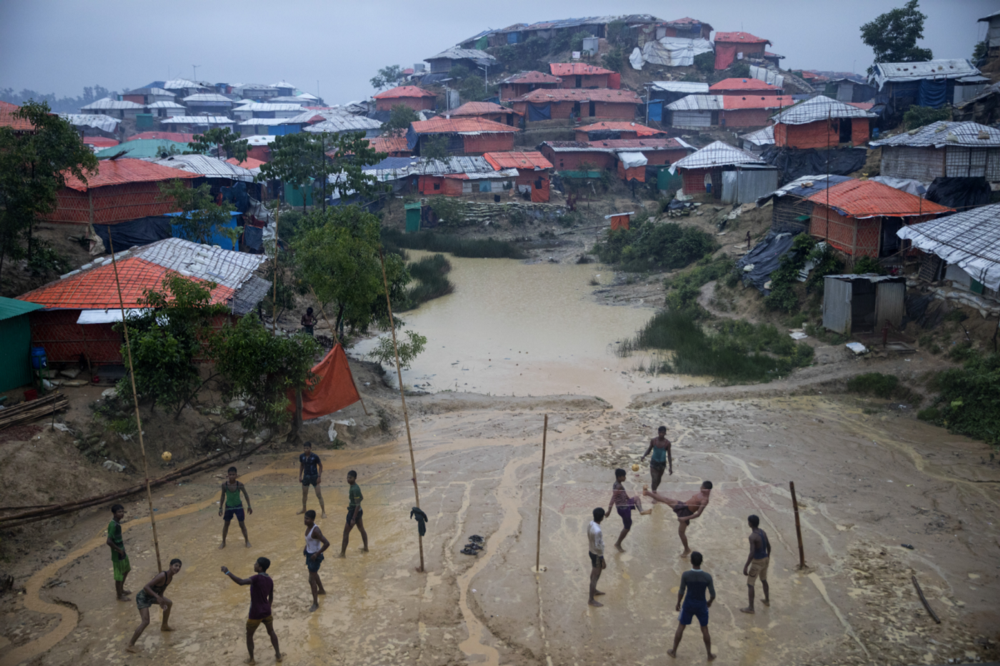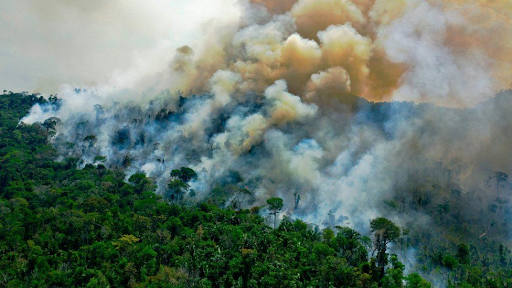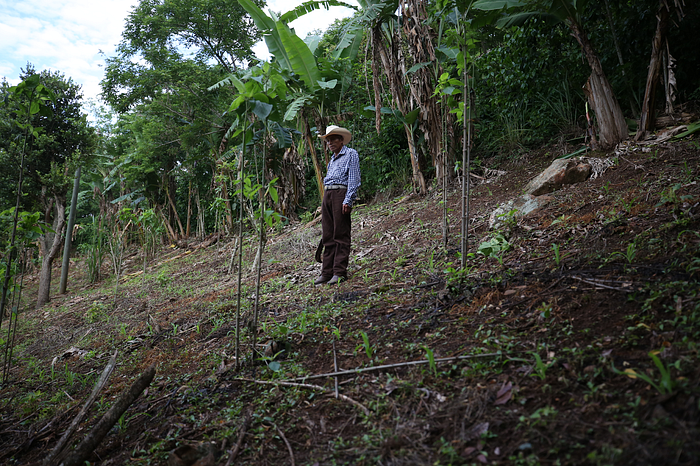Defining Refugees in the Era of Climate Displacement
HUMAN RIGHTS, 2 Aug 2021
Dewi Zarni | BIMI at UC Berkeley - TRANSCEND Media Service

In Bangladesh’s refugee camps, evacuation due to flooding is increasingly common. Paula Bronstein/Getty Images.
27 Jul 2021 – July 28th marks the 70th anniversary of the 1951 UN Refugee Convention. This historic document, signed by 149 nation-states, defines refugees as those with a well-founded fear of persecution if returned to their country of origin on the basis of their “race, religion, nationality, membership of a particular social group, or political opinion.”¹ It also outlines the rights afforded to refugees, including safety, liberty, and education, as well as the obligations of states who receive them. Created in the aftermath of World War II, the convention was amended in 1967 to remain in force, without geographic restrictions.
Now, seven decades after its ratification, it is time to expand this definition once again, in order to recognize and protect the growing number of people displaced by the climate crisis.
The Problem: A Current — and Future — Climate Crisis
Though often framed as a threat to future generations, the worsening effects of climate change already displace millions each year. Extreme weather events, which are growing more frequent and severe, have displaced, within their own countries, an average of 24 million people annually since 2008². What is already a crisis is set to reach an unprecedented scale. The World Bank estimates that by 2050, 143 million people will be displaced by climate change in Latin America, Subsaharan Africa, and Southeast Asia alone³. This displacement stems from increasingly extreme weather events, such as tornadoes, floods, droughts, and wildfires, in addition to sea level and temperature rise. The changing weather also impacts agriculture, leading to economic and food insecurity, and it exacerbates conflicts⁴. Climate change is therefore considered a “threat multiplier,” as it worsens existing drivers of displacement⁵.
While the UN has recognized the growing population of climate migrants and called for measures to mitigate the crisis, the organization has opposed amending the refugee convention to include them⁶. Dina Ionesco, Head of the Migration, Environment and Climate Change division of the International Organization for Migration, argued in an article that expanding the definition would be a lengthy process and could weaken the Convention if countries use the opportunity to change other parts of the agreement. Further, Ionesco claims that climate migration is not necessarily forced and that countries should focus on preventing displacement in the first place⁷. But some researchers, policymakers, and migrant organizations note that the unprecedented magnitude of the unfolding crisis requires unprecedented action on a global scale, including the expansion of our conception of refugees.

The number of fires in the Amazon increased by 80% from 2018 to 2019, threatening to displace Indigenous communities. Getty Images.
Why We Must Expand and Update the Convention
While combating the climate crisis and preventing displacement in the first place is vital, researchers concur that some climate displacement will continue to occur even if the most ambitious measures are taken. Modest actions to reduce emissions can cut the number of predicted climate migrants from Central America and Mexico to the United States by nearly 50%, but that still leaves an estimated 700,000 climate migrants by 2050⁸. A just and managed transition from fossil fuels to clean renewable energy is essential, in addition to investment in climate-resilient infrastructure to protect communities impacted by sea-level rise, drought, and other aspects of the crisis. But failing to recognize the reality of climate displacement will only leave the most vulnerable behind. The recognition of climate migrants is just one step towards addressing the numerous disastrous impacts of the climate crisis, and must be accompanied by actions that mitigate the effects of the climate crisis, including sustainable and weatherproof infrastructure, monetary aid to vulnerable nations, and the end of fossil fuel extraction and use.
Granting refugee status to those displaced by the climate crisis is a key step. Doing so recognizes the threat of climate displacement and legitimizes the right of the displaced to migrate. As island nations are submerged under water and farming communities turn to deserts, hundreds of millions of people will be forced to abandon their homes, regardless of international law. Failing to prepare for their migration and resettlement will only lead to mass statelessness and death. Even worse, should the Global North, which is better able to protect itself from the early impacts of the crisis, continue on the current path of xenophobia and nationalism, spending billions on militarized borders and walls rather than investing in the infrastructure to support migrants and combat the climate crisis, we will be responsible for millions of preventable deaths⁹.
We can continue building walls around our shrinking portions of habitable land, or we can invest in the future of our planet, facilitate the resettlement and integration of climate migrants, and create sustainable communities for generations to come.
Taking Leadership and Responsibility

By limiting refugee status to those who face persecution on the basis of their identity or political views, the convention excludes the millions of people facing equally dangerous threats to their lives, also for reasons beyond their control. The existing narrow criteria raise important and difficult questions surrounding the right to migrate. When migration is an issue of life and death for many, why should the nature of the threat determine whether the law recognizes someone’s right to live? Is persecution a more worthy reason to flee than poverty, famine, or natural disaster? And who are we to say? The current definition implies that economic, food, and climate migrants are somehow responsible for the life-threatening conditions they face and are therefore less deserving of support. But if anyone is responsible for this crisis, it is the nations and corporations knowingly exacerbating its effects through extractive and polluting practices.
Western nations, who have exploited the Global South’s resources and disproportionately contributed to the climate crisis, bear a significant responsibility for the displacement which our actions and policies helped to create. The United States, for example, comprises only 4% of the world’s population but contributes ⅓ of the excess carbon dioxide in the atmosphere¹⁰. Recognition of the major contribution to climate change from the most industrialized countries, and also that its impacts are disproportionately felt by less industrialized countries who are least able to mitigate them, has led to calls for climate reparations. For example, in This Land Is Our Land: An Immigrant’s Manifesto, Suketu Mehta argues for quotas for climate refugees proportional to a country’s contribution to the crisis. However, to date, the wealthy countries that have contributed the most pollution have not embraced this concept¹¹.
For those who argue that amending the convention is unfeasible, the Othering and Belonging Institute’s report Climate Refugees: The Climate Crisis and Rights Denied proposes the recognition of “petro-persecution,” a deterritorialized understanding of the impact of dependence on fossil fuels as a form of persecution, as a means to extend the status of “refugee” to climate migrants without amending existing Conventions. A similar approach has been used for victims of gender-based violence, who are not explicitly named in the Convention, but have been recognized as a “particular social group” subject to persecution. Climate refugees could also be considered a particular social group. Another option — one that the United States could pursue without changing the UN Convention — would be the creation of a new form of Temporary Protected Status (TPS) for climate-displaced migrants with a path to citizenship, given that the nature of climate disaster is no longer temporary.
In short, there are numerous paths by which to recognize climate displacement, by the international community and by individual Western nations like the United States. One thing is clear, however — there is little time to waste.
Footnotes:
¹https://www.unhcr.org/en-us/1951-refugee-convention.html
²https://www.npr.org/sections/goatsandsoda/2018/06/20/621782275/the-refugees-that-the-world-barely-pays-attention-to
³https://www.worldbank.org/en/news/infographic/2018/03/19/groundswell—preparing-for-internal-climate-migration
⁴ https://www.unhcr.org/en-us/climate-change-and-disasters.html
⁵ https://www.unhcr.org/en-us/climate-change-and-disasters.html
⁶ https://www.unhcr.org/en-us/climate-change-and-disasters.html
⁷https://www.un.org/sustainabledevelopment/blog/2019/06/lets-talk-about-climate-migrants-not-climate-refugees/
⁸ https://www.nytimes.com/interactive/2020/07/23/magazine/climate-migration.html
⁹ https://www.nytimes.com/interactive/2020/07/23/magazine/climate-migration.html
¹⁰ Suketu Mehta, “This Land is Our Land: An Immigrants Manifesto,” 104.
________________________________________
Dewi Zarni was born in 1999. Her father, Maung Zarni, is a member of the TRANSCEND Network for Peace, Development, Environment. She is a fourth-year UC Berkeley student majoring in American Studies with a concentration in Migration and was exposed to the complexities of the immigration process and its impact on families through her father’s experience as an asylee from Burma/Myanmar. As an Undergraduate Research Fellow with the Berkeley Interdisciplinary Migration Initiative (BIMI), she is currently working on the Mapping Spatial Inequality initiative, as well as the East Bay Sanctuary Covenant’s Amplifying Sanctuary Voices project on climate migration.
Tags: Climate Change, Human Rights, Immigration, Migration, Paris Climate Agreement, Refugees, UN Refugee Convention
DISCLAIMER: The statements, views and opinions expressed in pieces republished here are solely those of the authors and do not necessarily represent those of TMS. In accordance with title 17 U.S.C. section 107, this material is distributed without profit to those who have expressed a prior interest in receiving the included information for research and educational purposes. TMS has no affiliation whatsoever with the originator of this article nor is TMS endorsed or sponsored by the originator. “GO TO ORIGINAL” links are provided as a convenience to our readers and allow for verification of authenticity. However, as originating pages are often updated by their originating host sites, the versions posted may not match the versions our readers view when clicking the “GO TO ORIGINAL” links. This site contains copyrighted material the use of which has not always been specifically authorized by the copyright owner. We are making such material available in our efforts to advance understanding of environmental, political, human rights, economic, democracy, scientific, and social justice issues, etc. We believe this constitutes a ‘fair use’ of any such copyrighted material as provided for in section 107 of the US Copyright Law. In accordance with Title 17 U.S.C. Section 107, the material on this site is distributed without profit to those who have expressed a prior interest in receiving the included information for research and educational purposes. For more information go to: http://www.law.cornell.edu/uscode/17/107.shtml. If you wish to use copyrighted material from this site for purposes of your own that go beyond ‘fair use’, you must obtain permission from the copyright owner.
